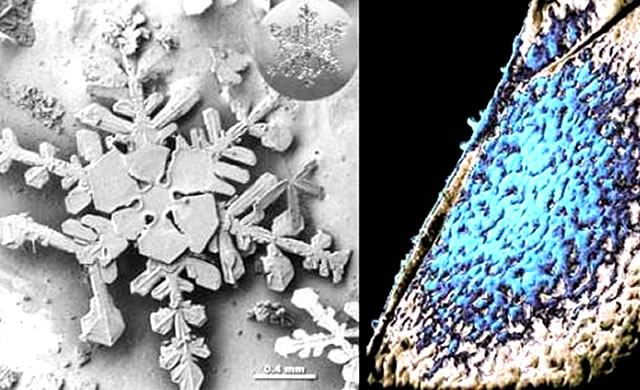
The familiar forms of ice, including snowflakes (left), are built from crystals, but amorphous ice (right) is unstructured.
Credit: NASA/Earth Observatory (left image) and NASA/ARC/P. Jenniskens and D.F. Blake (right image)
Dietro a porte chiuse rigorosamente a chiave, in un laboratorio costruito come un rifugio antiaereo, Perry Gerakines fa qualcosa di apparentemente “normale” se non fosse… quasi alieno: il ghiaccio.
Questo non è il ghiaccio dei fiocchi di neve o dei comuni cubetti di ghiaccio. No, questo ghiaccio necessita di temperatura estremamente bassa per ricreare condizioni molto rare, semmai potessero essere presenti in natura sulla Terra. E quando Gerakines crea questo ghiaccio, si deve immaginare un livello microscopicamente sottile da far impallidire un singolo grano di polline.
Questi strati ultrasottili si rivelno perfetti per ricreare le condizioni chiave della chimica che si trova nello spazio. In queste piccole provette, Gerakines ei suoi colleghi del Cosmic Ice Lab at NASA’s Goddard Space Flight Center in Greenbelt, nel Maryland, sono in grado di riprodurre le reazioni nel ghiaccio da quasi qualsiasi momento e luogo della storia del sistema solare, tra cui alcuni che potrebbero aiutare a spiegare l’origine della vita.
Behind locked doors, in a lab built like a bomb shelter, Perry Gerakines makes something ordinary yet truly alien: ice.
This isn’t the ice of snowflakes or ice cubes. No, this ice needs such intense cold and low pressure to form that the right conditions rarely, if ever, occur naturally on Earth. And when Gerakines makes the ice, he must keep the layer so microscopically thin it is dwarfed by a grain of pollen.
These ultrathin layers turn out to be perfect for recreating some of the key chemistry that takes place in space. In these tiny test tubes, Gerakines and his colleagues in the Cosmic Ice Lab at NASA’s Goddard Space Flight Center in Greenbelt, Md., can reproduce reactions in ice from almost any time and place in the history of the solar system, including some that might help explain the origin of life.
Source/Continue reading → phys.org





















